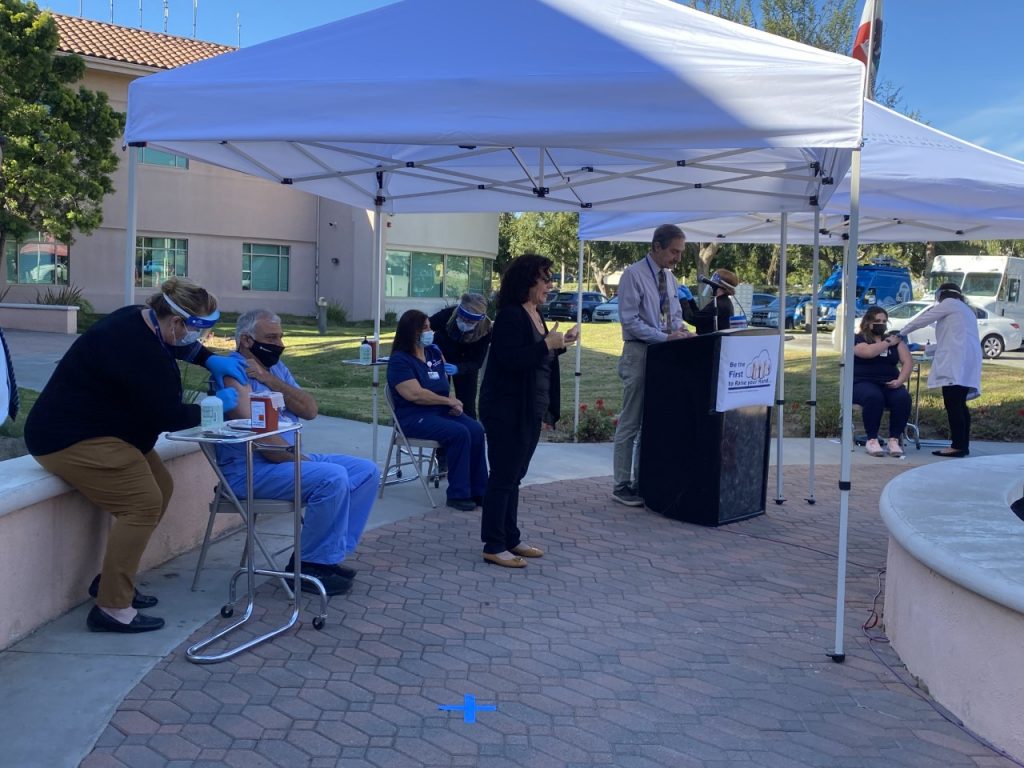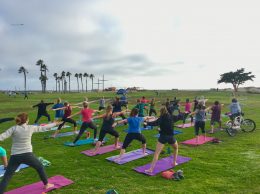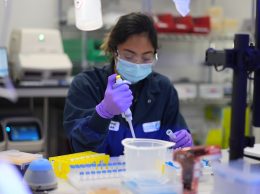Moderna exec tells of company’s pursuit of COVID vaccine
IN THIS ARTICLE
- Health Care & Life Science Topic
- pacbiztimes Author
By pacbiztimes Thursday, February 18th, 2021
Moderna didn’t expect to go to market with its new vaccine technology for several years when 2020 began, the company’s CFO said in a recent talk, but that changed after the technology Moderna spent almost a decade developing helped fast-forward development for COVID-19 vaccines.
More than 1,000 people watched a virtual discussion on Feb. 17 between California Lutheran University economist Matthew Fienup and David Meline, the CFO of Moderna, as they talked about Moderna’s COVD-19 vaccine, the pandemic and the pandemic’s effects on the economy.
The discussion was moderated by Harry Nelson, the founder of Nelson Hardiman, a Los Angeles-based health care and life sciences law firm, and hosted by the 101 Corridor chapter of the Association for Corporate Growth.
Nelson asked Meline to give the audience a general feel for where Moderna was as a company before the pandemic. Meline said Moderna had been working on developing a new vaccine technology for almost 10 years before the pandemic, but the company wasn’t ready to go to market—and didn’t expect to have a product it could go to market with for another four or five years.
“Usually you don’t get a chance to launch a technology in an environment like you have today,” Meline said. “Normally you do things in sequence. You take one step and proof it out, you take another step and proof it out, and that’s what adds time to the process.”
Because of that, Moderna didn’t have the manufacturing capabilities or corporate infrastructure to create clinical trials and distribute a vaccine, or people who could connect with countries and sell the finished project when it was done. Meline had to help the company build all of that within a matter of months, and he had to do it completely virtually.
“I’ve never met any other employees,” said Meline, who has also been the CFO of Thousand Oaks-based Amgen. “We’ve done it all remotely.”
Meline credited the U.S. government and the military for helping Moderna get the pieces of the supply chain it didn’t already have. The United States ordered 300 million doses of Moderna’s vaccine, along with 300 million of the Pfizer/BioNTech vaccine. Once Moderna hands the vaccine to the government, that’s the end of the company’s involvement—Moderna has nothing to do with vaccine delivery or distribution among communities.
Though there is still reluctance among some people about the vaccine, Meline said that the vaccine is becoming its own best advertising. As more and more doses are delivered to communities, especially the most vulnerable ones, residents are seeing an extremely low level of adverse effects in comparison to the protection the vaccine gives.
“You’re seeing a very strong downward trend in hospitalization and death, and it’s strongly correlated with vaccination,” Meline said.
Moderna is still doing several trials to test the vaccine’s safety and effectiveness in some groups. The company is now doing a trial on 12-18-year-olds that could result in an approval for children to get the vaccine before the start of the new school year in fall.
Moderna is also looking to do a trial on children 11 and younger. Even though children are less likely to get severe forms of the disease, they can still spread it to other family members who might be more susceptible.
Meline, like many in the industry, is also suspecting that COVID-19 will be around for a while.
“It’s pretty clear that there’s going to be a market that looks like the flu market, where every year you have a new variant of flu,” Meline said. “We expect to see that for the next several years with COVID-19.”
The virus has already started mutating in ways that make it more spreadable, and as a result Moderna has launched additional trials to see if it can address some of the variants with a booster shot of the vaccine or a revised vaccine designed to protect against the South African variant.
Having a vaccine this early is already helping the country recover. More traditional vaccines can take up to 10 years to manufacture, and Fienup said if the vaccine wasn’t already ready and in distribution, the world would look like a much different place.
“We can’t celebrate it enough,” said Fienup, the executive director of CLU’s Center for Economic Research and Forecasting.
COVID-19 has had a disproportionately large effect on the most vulnerable people, and Fienup focused on that when he spoke of the economy both now and in the future, when the vaccine has been more widely distributed
Vaccine adoption and political courage to lift the COVID-19 restrictions once it’s safe will help in the short and medium term, but in the long term, Fienup said there needs to be a focus on unwinding the “extraordinary political steps” the state and nation had to take during the pandemic and then figure out how to prepare for other, similar disasters in the future.
In particular, Fienup advocated for an urgent drive to reduce government debt, as an overabundance of debt could act as a drag on the economy and raise the risk of inflation and higher taxes in the future.
“That debt will be paid back on the backs of the children and grandchildren of the low-wage earners of today,” Fienup said.

Related Articles
 Friday, July 8th, 2022
Friday, July 8th, 2022
Businesses adapt as cities end pandemic policies that allowed free use of public spaces
 Wednesday, May 11th, 2022
Wednesday, May 11th, 2022
For small businesses, pandemic offers lessons in preparing for the next disaster
 Friday, April 8th, 2022
Friday, April 8th, 2022









